Mopping up in Argentina
Targeting Giant Rainbow Trout in Argentine Patagonia's Jurassic Lake (Lake Strobel)
Article and photography by IGFA Representative Pat Ford
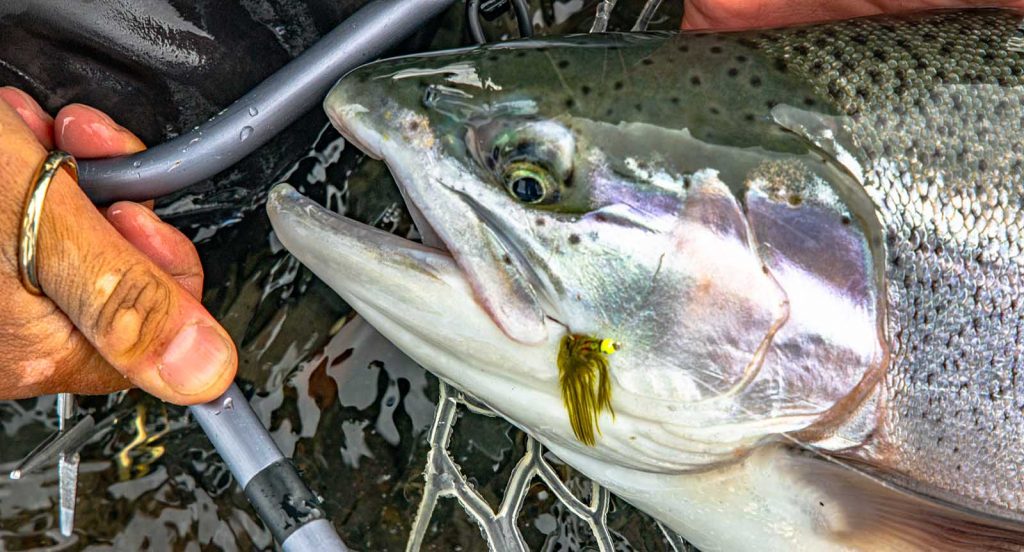
I had heard about Jurassic Lake for many years before I actually got there. Its actual name is Lake Strobel and it’s located in southern Argentine Patagonia, a seven-hour drive from Calafate, which is the nearest point of civilization. The landscape surrounding the lake is pretty much what you’d expect to see on Mars; rough, dry and lifeless. Occasionally you’d see a rabbit or fox or guanaco (Lama guanicoe), but there was very little else if you don’t count birds. The lake is fed by the Barrancoso River which is pretty much the only tributary and there is no outflow. Basically, it’s in the middle of nowhere!
Evidently, in the mid-90s someone decided that the ponds around the lake would be a great place to raise, and commercially harvest rainbow trout. Steelhead from the Santa Cruz River, and rainbow trout eggs from the McCloud River were brought in and dumped into the ponds and river and, as a lark, also in the lake. Unfortunately, the hatchery plan had a few glitches. The lake and its ponds had no road access, boats or even accessible shorelines. There was no way to profitably harvest the trout much less get them to market, so the whole plan was quickly abandoned, but the eggs had been planted and nature took over.
As it turned out, Lake Strobel’s scud and nymph abundance was perfectly suited for rainbow trout, and the lake’s hatchlings flourished. With literally no predation, the trout grew to enormous sizes. Then in 2006, Klaus Frimor and Christer Sjoberg heard rumors of a lost lake with giant rainbow trout and decided to go check it out - but first they had to find it. Christer owned Loop Adventures and Klaus was managing his lodge on the Rio Gallegos at the time. It turned out to be a 12-hour drive to Lake Strobel but what they found caught their attention immediately. There was absolutely no habitation on or even near the lake. They lived in tents and explored miles of shoreline including the river mouth. Klaus told me that the fish at the river mouth would eat just about anything, but it took a while for them to figure out the best flies for the rest of the lake and the ponds, but the trout averaged 10 pounds. They both agreed that they had to develop an operation to fish Lake Strobel on a regular basis. Christer’s company, Loop Adventures, signed a lease with the owner of the land around the river mouth. Eventually, a few rough buildings were constructed to house the generators and supplies, and anglers were brought in from Calafate. There were no amenities such as plumbing or electricity and it was pretty much camping, but the fishing was off the charts. Fast forward a dozen years and Jurassic Lake Lodge is as comfortable as it gets and the fishing is still off the charts, which is what prompted our trip.
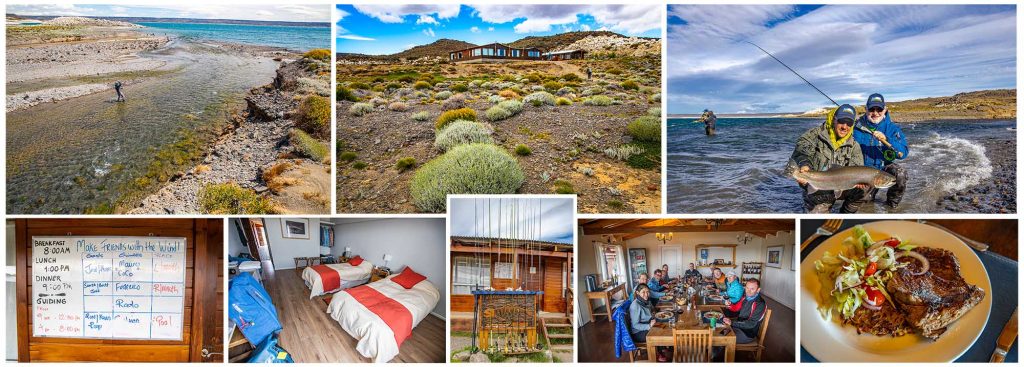
I had just stepped off the Twin Otter plane that had flown us from Comodoro Rivadavia to the Lodge’s private landing strip when my hat blew off. It landed about 30 feet away and was immediately snatched up by one of the guests just leaving the lodge and returned with a smile. His smile was a premonition of the week to come. I was about to experience the most amazing rainbow trout fishery I could possibly imagine, but clearly I had to learn how to make friends with the wind.
It only took a few minutes to drive from the landing strip to the lodge where we were assigned rooms and offered a snack before lunch. At 1 pm we were all in the dining room and given the basic rules - breakfast at 8 am, lunch at 1 pm and dinner at 9 pm. We would be in groups of two or three and assigned beats or sections of the lake to fish each day. Guides would be with us from 9 am -12 pm and then again from 4-8 pm. The good news was that all the beats were within walking distance of the lodge and we were free to fish on our own any time we liked. We had to use barbless hooks for our own safety as well as the trout; this was not the place to get a barbed hook in the eye being so desolate. The only restriction on flies was no Alaska-style plastic egg rigs. The lodge is located at the mouth of the Barranoco River, which could be fished at the mouth, up to a pool called the “aquarium” and above where the river and pools were considerably smaller. Much to my surprise we were told that 90% of our fishing would be with floating lines. We were also told to expect wind and lots of it. However, it shouldn’t affect the fishing too much, as long as it stayed below 50 mph. One day it actually got to 70 mph with gusts to who knows what.

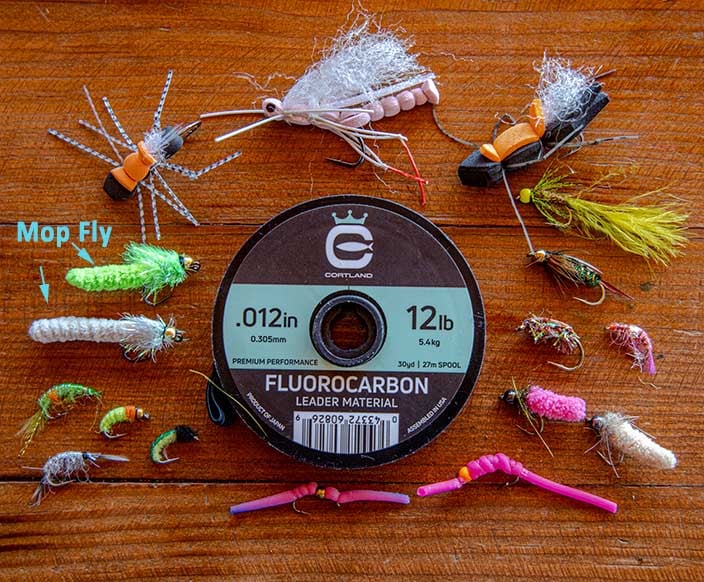
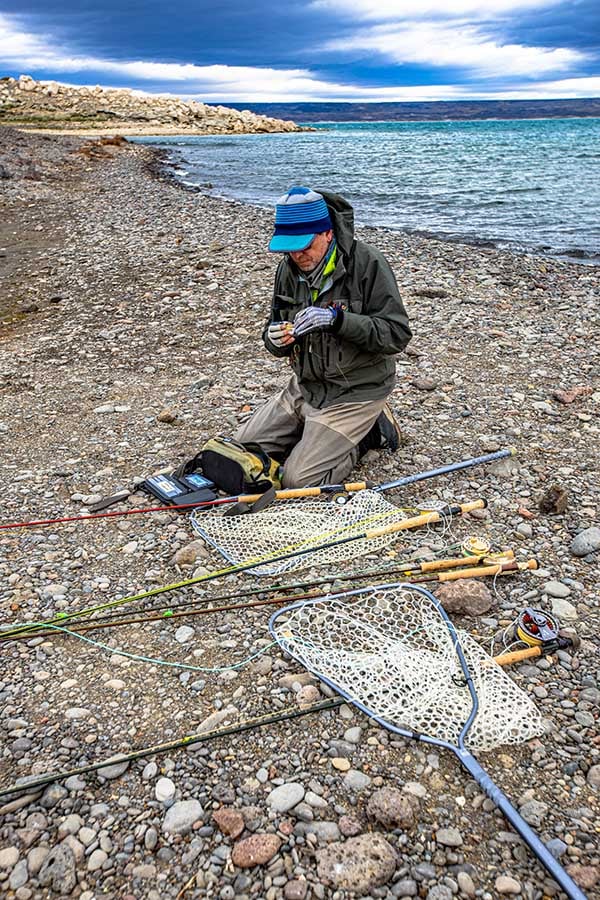
I had put together the group of anglers for this week, so we were all friends. That first afternoon Rodger Glaspey and I headed out to the “aquarium” right after lunch. We had done some research on the most effective flies and had settled on a small olive woolly-bugger style nymph with a hot pink bead head and a new creation called a mop-fly. I had never even heard of a mop-fly, but Rodger had brought a few with him and the Lodge actually sold them. I’ve found that no matter how many flies I bring on a trip, I wind up buying a bunch on site, and it’s part of the fun! The mop-fly was no exception. It was about an inch long, had a sparkle neck and a bead head. The body was made out of a piece of chenille mop sold in stores for dusting and it came in white, chartreuse and pink. The white one looked like a giant maggot. I have no idea why pink and chartreuse also worked. I picked up three of each and after lunch I rigged a white one up on my 9’6”, 7-weight Loop Cross S1 along with a strike indicator and a Cortland 12-pound fluorocarbon leader. We didn’t have a guide but we were pretty confident we could figure things out on our own.
As we walked up to the river where it entered the pool, we could spot several double-digit rainbows holding in the current. Rodger swung his olive hot head through them, immediately hooked up, and we were off to the races. That afternoon was undoubtedly the best trout fishing we had ever experienced. Our guide showed up around 4 pm and we fished till 8 pm. By a rough count we had 35 fish over 10 pounds and five that were in the 17-pound range. We didn’t count anything we thought was under 10! As we were walking back to the lodge, our guide told us that he had never seen so many big fish caught in one session at that pool. I had never even seen a 17-pound rainbow before, and Rodger caught a 31-inch rainbow on a dry fly. We were afraid to tell the rest of the guys how lucky we had been, and we figured they wouldn’t believe us anyway. The size of these fish was simply insane. That evening we were assigned beats and the serious fishing was about to begin.
"By a rough count we had 35 fish over 10 pounds and five that were in the 17-pound range. We didn’t count anything we thought was under 10!"
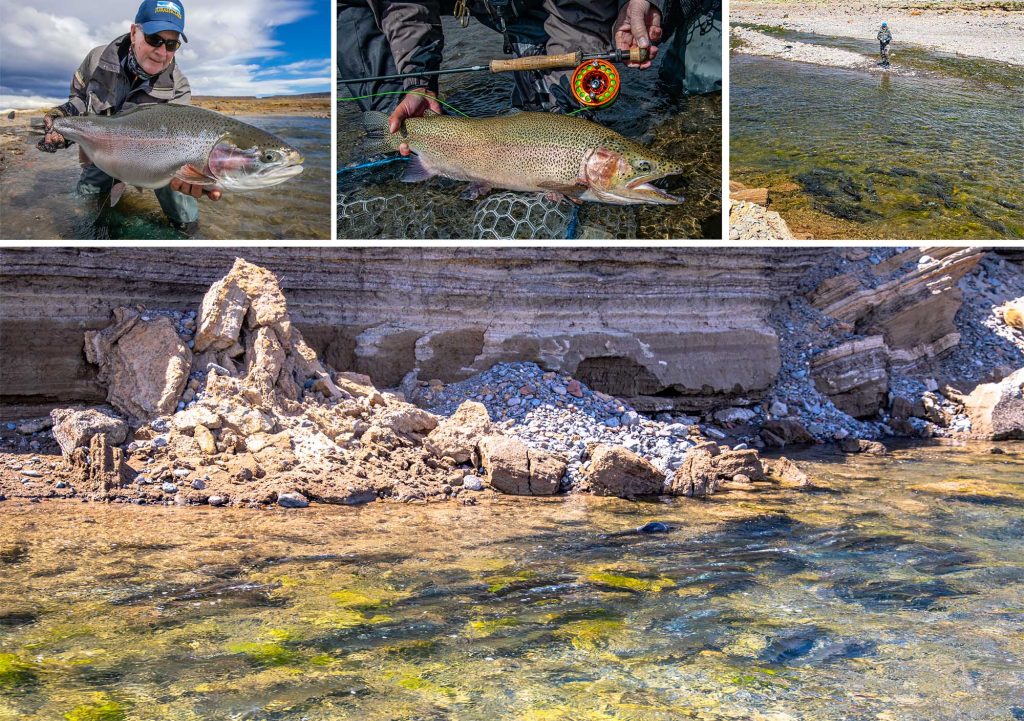
Jurassic Lake Lodge is set at the mouth of the only river feeding the lake. Moving clockwise, the first beat is “Bay of Pigs” where you fish off some of the interesting rock formations that surround the lake. The water drops off sharply and the footing can be tricky, but some super big fish patrol the edges, hence the name. There are two beats at the river mouth, right and left. There is a shallow stretch a bit up from the mouth that is easily crossed so one group would wade across and fish the right side of the mouth and also the river upstream of the mouth. The guys on the left fished the mouth and the beach to the left but could venture up the river if they liked. The pool was another beat, and it was also possible to go upstream of the pool and sight fish the smaller stream, which had pools full of 10-pound rainbows, with dry flies and five-weight setups. You’d fish one beat in the morning and another in the afternoon and continuing rotating around through them.

I used a Loop 10-foot, 8-weight rod for the lake and the 7-weight for the pool. One of my buddies used a Loop 7-weight switch rod for the lake which also was very effective. The lake was always windy, and the combination of wind and current outflow resulted in a constant chop which made mending with a shorter rod difficult at times. I know the extra length helped me a lot and next time I’ll probably bring a switch rod too. Most of my fishing was with a mop fly, scud or nymph below a standard strike indicator, but most of the guys used a giant foam salmon fly with the nymph dropper. If you liked to swing flies, a Teeny mini sink-tip worked perfectly, especially at the river mouth. A full intermediate line worked best at the “Bay of Pigs” if you were using streamers.
The farther up-river you went, the lighter the rod you needed. In the higher pools 4 and 5-weights were fine with light tippets for the dry flies, but there were still plenty of fish over 10-pounds. It was interesting to watch the rainbows move up stream through the shallow sections. The fish were so big and the water so shallow that their backs actually got sunburned. We could see lots of fish with scars and wounds on their backs which were the result of being exposed to the wind and sun. These scarred up fish were spotted both up-river and in the lake, so they moved back and forth continually.
This is a magical fishery and the holy-grail there is a 20-pound class rainbow. The fish fit several categories:
- Under 10 which covered everything clearly not 10-pounds,
- 10-pounds which was pretty much a 30-inch fish that was thin,
- 15-pounders which were either a short very fat fish or a very long thin fish, and
- 20 which was reserved for the monsters. I’m talking about fish over 30-inches and fat. If you didn’t think “Oh My God’ when you first saw it in the net, it wasn’t in the 20- pound category.
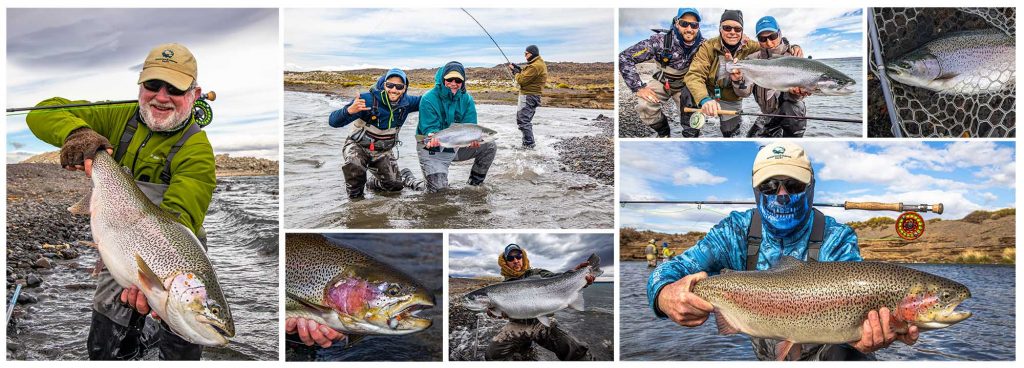
I caught two in that 20-pound class and Rodger caught three, two of which were closer to 25 pounds. Rodger owns Rainbow King Lodge in Alaska but neither of us had ever seen anything like these monsters. Our group had a total of nine “20s” for the week which is exceptional, even for Jurassic Lake Lodge standards. What was interesting was that every one of the 20 pounders was caught on the mop fly.

Strikes could be very subtle, or the indicator simply disappeared. I started out with a white indicator but kept losing it in the white foam that the wind was kicking up, so I switched to orange. I was concerned that the extra visibility would be a problem until a 10-pound rainbow ate it. The guys who were using the foam flies as indicators caught several fish on them. Every cast could produce anything from a dink to a monster and they all fought like crazy. Runs went well into the backing and even some of the biggest fish would come completely out of the water over a dozen times. They were spectacular.
I’ve mentioned the wind, but not nearly enough. This area of Argentina is pretty much flat from the ocean to the Andes. The wind blows all the time and it can reach unbelievable speeds. Normal is around 30 mph which is easily fishable. The pool is the most protected area as is the river above the mouth. The “Bay of Pigs” is the worst. At one point the wind was steady at 70 mph with gusts! We actually tried fishing the mouth but it was a challenge to say the least. The river was better but bay of pigs was out of control. There was six feet of spindrift over the entire lake and most of us took the afternoon off that day. In hindsight, it just added to the adventure.
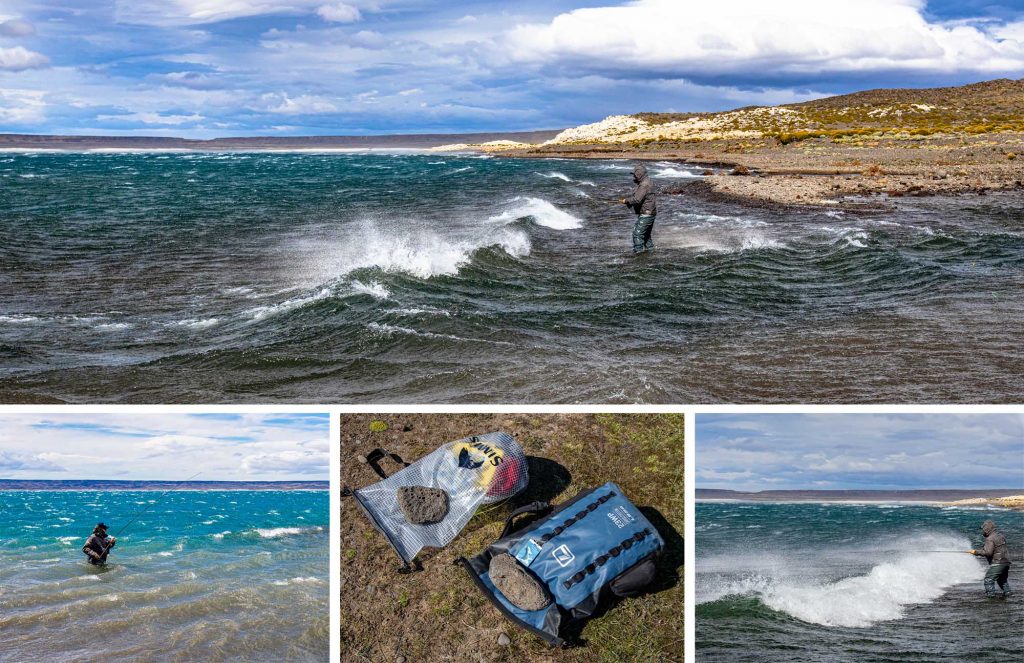
We did notice that the lake was calmest at daylight, so it didn’t take long for Rodger and I to sneak in a little fishing before breakfast. One morning, Rodger caught two of his monsters at the mouth at daylight on a mop fly. There’s something about that fly that attracted the bigger fish. It would bob along under the strike indicator, jumping up and down with the waves, which at the mouth could be substantial. Whatever it looked like, it was on the big fish menu. I was obsessed with landing a 20-pounder and the mop was pretty much all I used except one day when they were going nuts over green scuds. Everyone had their own secret fly that worked for them and as usual, you caught most of your fish on whatever was on your line most of the time.
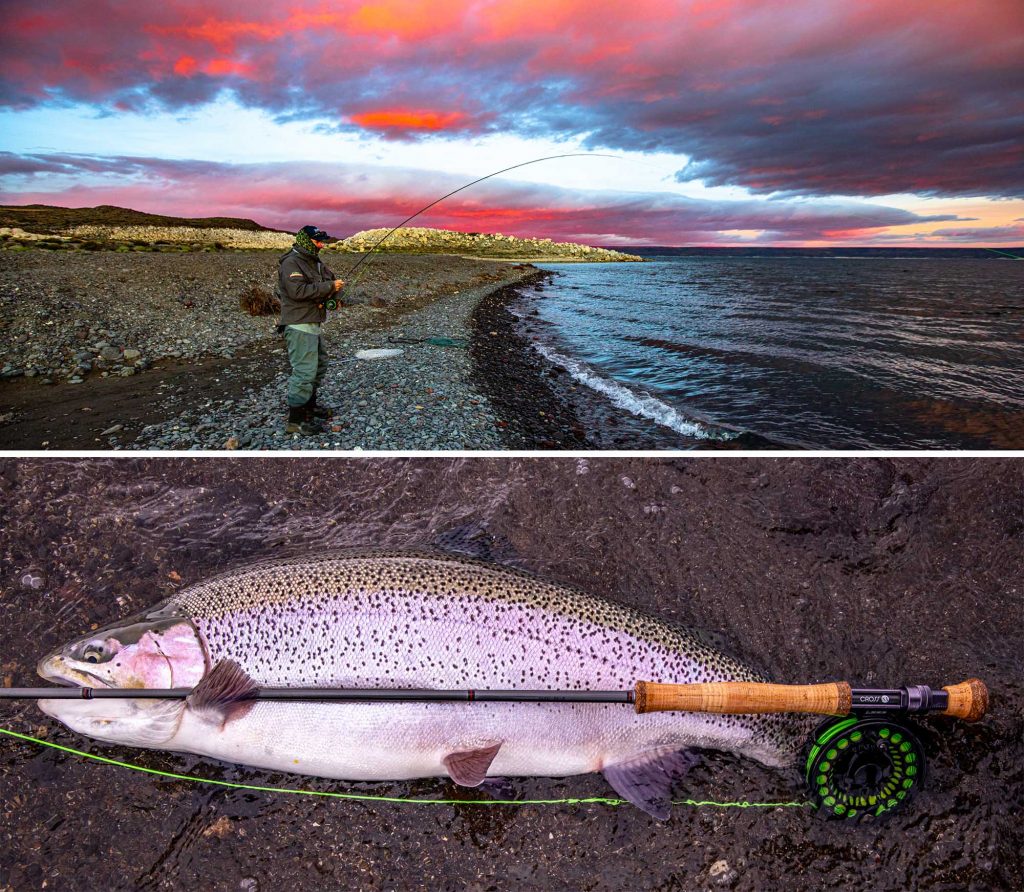
Our trip was in December and it’s hard to imagine it being any better. According to the guides, the fishing is outstanding from opening day in October through December, after which it slows down to merely amazing. Monsters are caught every week of the year, but in April the wind dies and 90% of the fishing is done with dry flies. I can only imagine 15-pound class rainbows on dry flies and 5-weights. Check out jurassiclake.com for more information on the Lodge and mopfly.com for this crazy new fly.
